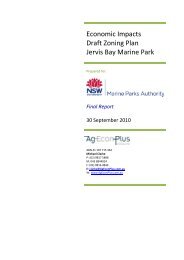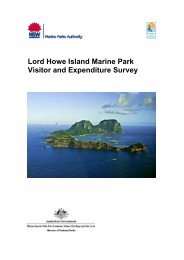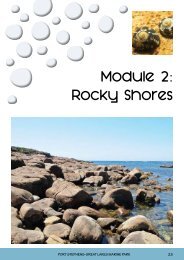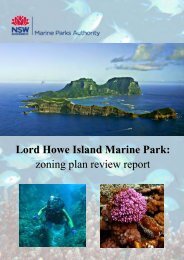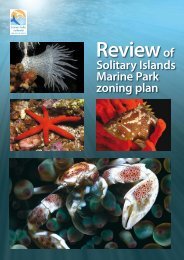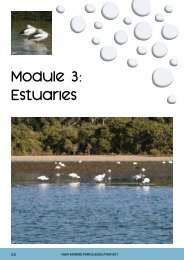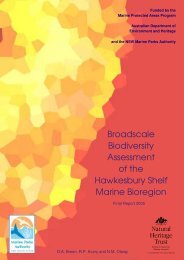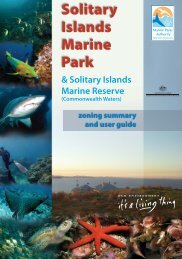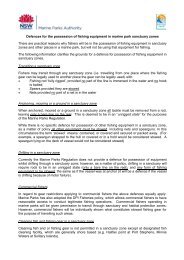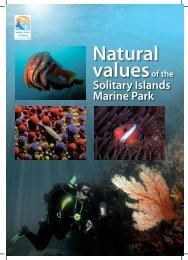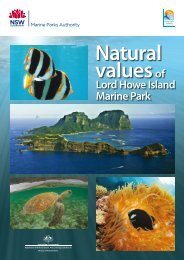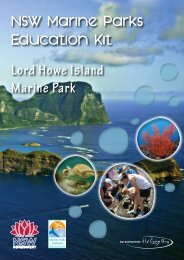Research Project Summaries 2002-2009 - Marine Parks Authority ...
Research Project Summaries 2002-2009 - Marine Parks Authority ...
Research Project Summaries 2002-2009 - Marine Parks Authority ...
You also want an ePaper? Increase the reach of your titles
YUMPU automatically turns print PDFs into web optimized ePapers that Google loves.
Assessing potential impacts associated with increasing coastal urbanisationIn northern NSW, coastal populations are forecast to increase dramatically over thenext 25 years. However, management of the effects of development on marinecommunities is hampered by lack of data on the composition and likely impacts on keyhabitats. Consequently, a protocol has been developed to assess the biodiversity of,and current human impacts on, nearshore reefs – habitats that will be readily affectedby coastal development (Smith et al 2008). To assess this protocol, four reefs nearpopulation centres were surveyed – including near Coffs Harbour and in the marinepark – examining fish, mollusc and sessile benthic communities and debris loads. Asuite of methods provided as wide an assessment of reef condition as practicable.Thus, transect surveys of fish and molluscs, and video transects of benthic communitystructure were combined with assessments of debris load and surveys of coral healthand condition (e.g. bleaching and disease).The reefs’ community structures were highly variable over all spatial scales, indicatingthat reefs should not be considered to have the same composition when planningdecisions are made. While debris loads were relatively low on most reefs surveyed,those with highest conservation value also had the highest debris loads. This suggestspotential conflict between human use and long-term sustainability of reef communities(Smith et al 2008).Impacts of vehiclesThe impact of four-wheel drive vehicles on the meiofaunal community of sandybeaches was examined (Bell 2005). The experiment incorporated a Beyond BACI(Before/After, Control/Impact) design with replicated control and impact treatments(low, medium and high). Each impact treatment corresponded to a specific number ofvehicles passing per day; 10, 20 and 40, respectively. Impact treatments occurred eachday for a week, with samples collected directly before and after impact in alltreatments. A detectable effect was only apparent for copepods; however, effects onother species may be masked by the high level of natural spatial and temporalvariation.There is evidence that vehicle access to saltmarsh areas at Saltwater Creek, ArrawarraCreek and Moonee Creek has caused extensive damage to plant cover and plantcommunities, and changed drainage patterns (Bateman 2003). Damage to a saltmarsharea at Saltwater Creek showed almost no recovery after two years of vehicleexclusion.4.1.2 PollutionPotential for a biomarker to indicate pollutionPollutants in estuarine benthic environments can cause negative effects. Biomarkerscan be used to measure how an organism responds to such stressors. A study byGoulden (2007) tested two main questions:whether reduced total haemocyte counts (THCs) and elevated haemolymphicbacteria can be used as biomarkers of stress in estuarine ghost shrimps(Trypaea australiensis)whether the shrimps show such stress responses in polluted systems and couldbe used to monitor ecosystem health (Goulden 2007).Shrimps were sampled from an estuary in good condition, with much of the catchmentin a national park or state forest (Wooli Wooli River), and from a more polluted estuaryin an urbanised and agricultural catchment (Coffs Creek). Laboratory exposure of aSolitary Island and Jervis Bay <strong>Marine</strong> <strong>Parks</strong> <strong>Research</strong> <strong>Project</strong>s <strong>Summaries</strong> <strong>2002</strong>–<strong>2009</strong> 31



